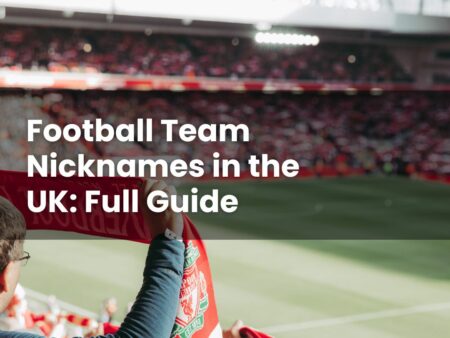Football has deep roots across England, shaping identities and bringing neighbours together every weekend. Yet, some large and historic towns have no club competing in the country’s professional football leagues. This doesn’t mean football is absent—it simply takes a different form.
This article explores which English towns lack representation in the top four tiers, why that happens, and how local people can still stay connected to the game. Understanding these gaps offers an interesting look at how football’s structure, geography, and finances influence where professional clubs thrive and where they struggle to take hold.
Which Places in England Do Not Have a Football Team?
In England, the top four tiers of professional football—the Premier League, Championship, League One and League Two—make up the English Football League system. Beneath this sits a large non-league pyramid, which includes hundreds of semi-professional and amateur clubs.
Many towns have football teams competing at these lower levels, but lack a club in the professional divisions. For example:
- Aylesbury (Buckinghamshire) – Aylesbury United plays in the Southern League Division One Central, several steps below League Two.
- Royal Tunbridge Wells (Kent) – Tunbridge Wells FC currently competes in the Southern Counties East League Premier Division.
- Corby (Northamptonshire) – Corby Town FC plays in the Northern Premier League Division One Midlands.
- Basingstoke (Hampshire) – Basingstoke Town FC competes in the Isthmian League South Central Division.
- Chesham (Buckinghamshire) – Chesham United FC plays in the Southern League Premier South.
Each of these towns has a proud footballing tradition, but none currently has a team in England’s professional top four divisions. Larger urban areas such as Wakefield in West Yorkshire also remain without a professional club, despite a population of over 100,000.
Why Are Some Towns in England Without a Football Team?
Several factors can help explain why certain towns may not be represented at a professional level. Geography, funding and local history all play a part.
- Proximity to established clubs: Towns close to major football cities often have fanbases that already support nearby professional sides. For example, many people from towns near London, Manchester or Birmingham travel to those cities for matches, instead of forming new professional clubs more locally.
- Financial demands: Competing professionally requires strong backing. Clubs must fund player wages, coaching staff, stadium maintenance, and travel costs. Ground facilities must meet strict safety and capacity standards set by the English Football League and the Football Association.
- Local sporting culture: Some areas have deep roots in other sports, such as cricket or rugby, particularly in parts of the Midlands and South West. This can reduce the community focus on football and make it harder for clubs to grow.
- Historic changes: Some towns once had stronger football presences that faded over time due to club closures, relocations or mergers. Without sustained investment and support, teams may drop down the leagues or disappear entirely.
These factors often combine, meaning a town’s absence from the professional structure is rarely down to a single reason.
How Do Towns Without Football Teams Support the Sport?
Even when no professional club represents a town, football remains a central part of local life. Many residents still engage in the game through several routes:
- Grassroots football: Schools, community centres and local leagues provide structured opportunities for people of all ages to play. These activities often help maintain strong connections between residents and the sport.
- Support for nearby clubs: Many fans travel to neighbouring towns or cities to watch professional matches, building shared routines with others from their community.
- Broadcast and digital coverage: The Premier League and FA Cup reach homes nationwide through live broadcasts, meaning interest in football continues regardless of a town’s professional status.
This ongoing participation shows how football’s reach extends well beyond league boundaries.
Notable Towns in England Without a Football Team
Some towns stand out for their size or history, yet remain without professional representation.
- Aylesbury – Population around 87,000. Aylesbury United last competed in the Football League in the 19th century. The club now plays at non-league level and currently groundshares outside the town.
- Royal Tunbridge Wells – With roughly 56,000 residents, the town’s main side competes regionally, rather than nationally.
- Corby – Around 72,000 people live here. Corby Town FC, nicknamed “The Steelmen,” has played non-league football since its formation in 1948.
- Basingstoke – Over 113,000 people live in this Hampshire town, which once supported a higher-level club before stadium issues affected progress.
- Chesham – Home to Chesham United FC, founded in 1917, competing at semi-professional level.
Each of these towns shows how strong local followings can exist without representation in the Football League.
What Factors Stop a Town From Having a Football Club?
Progressing to professional status requires much more than local enthusiasm. Some of the most common barriers include:
- Finance: A Football League-standard ground can cost millions to build or upgrade. Without sponsors or high matchday attendance, maintaining those standards can be difficult.
- Infrastructure: Clubs must meet specific ground grading criteria, including seated capacity, floodlights, and safety systems. These standards are essential for promotion through the National League System.
- Population size: A smaller supporter base makes it harder to generate enough income to sustain higher-level competition.
- Management and stability: Consistent leadership and clear planning are vital. Sudden changes in ownership or administration often set clubs back.
These challenges show how even football-loving towns can remain outside the top levels of the pyramid.
Do People in These Towns Support Nearby Teams?
Often they do. In many areas, people follow the nearest professional club, forming part of its extended fanbase. For instance:
- Fans from towns near Reading, Southampton or Milton Keynes often travel to those clubs for matches.
- Residents of Tunbridge Wells or Maidstone may follow Brighton & Hove Albion or Crystal Palace, both within manageable travelling distance.
Even without a local badge, these supporters help sustain the football culture around them. Matchdays can bring community activity—travel groups and local venues all play their part.
The Future of Football in Towns Without a Club
Clubs can climb through the divisions if they meet both performance and facility standards, creating real opportunities for growth when the foundations are strong. Investment, steady community support and a focus on developing young players can all help a club move forward sustainably.
The continued rise of women’s football, along with better grassroots facilities, is also expanding access to the game. More towns are now able to build clear pathways from youth level to senior football.
At the same time, technology is transforming how local teams connect with supporters—many non-league sides now live-stream matches and use social media to attract wider audiences and sponsorship.
While each town’s journey will differ, the direction of English football remains open and inclusive. With patience, collaboration and long-term vision, new opportunities can emerge—keeping the dream of professional representation alive in communities across the country.








